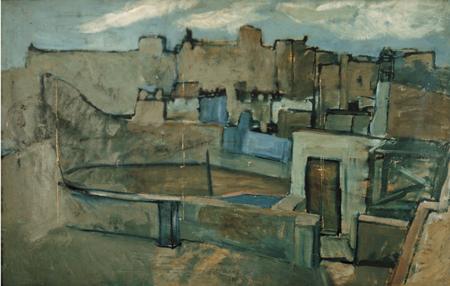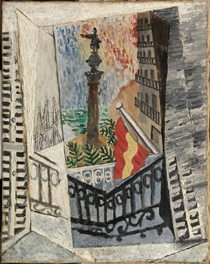From Cleveland to Barcelona: “Journey through the Blue: "La Vie”
Having La Vie in Barcelona is a privilege for the city. The return of this work to the physical space in which it was painted in 1903 takes us back to a period and a setting of creation where the bases of modernity were established. But as it tends to happen with majorworks, the media reaction of the time eclipsed other more modest creations that remained in second place, far from the critical look. The painting Barcelona Rooftops is a good example of this, and in spite of this oversight it has been a fundamental piece for the conception of this exhibition.
Cover of the exhibition catalogue © Successió Picasso.VEGAP 2013
“Journey through the blue: La Vie” is an exhibition that is based around these two works, but that has also allowed us to relate a series of drawings and a small painting, so connected to La Vie that we can no longer understand it without taking into account these other pieces that are part of its gestation. Without doubt La Vie is the star figure of the exhibition, but it is confronted physically and intellectually in a dialogue full of plastic nuances that boost and relate, for the first time, to other minor works. A radiography carried out of Barcelona Rooftops uncovered a hidden painting. From this point on, we have continued revealing new keys in the Picassian pictorial process, going deeper into the creative trail of the artist. Between 1900 and 1904 Picasso carried out a prolific and original production, orchestrating the transition from the chromaticism of 1901 to the blue period. A rigorous observation and a valuable intervention of the experimental sciences in the study of heritage made the materialization of the study possible.
Pablo Picasso, La Vie, 1903, Oil on canvas, The Cleveland Museum of Art, Gift of the Hanna Fund, 1945.24
Because in the same way as already happened in 1978 a radiography of La Vie transported us to a turn-of-the-century Barcelona, Barcelona Rooftops, analysed with scientific rigor, revealed the system of work of Picasso and new keys of the creation process of La Vie, at the same time as confirming the persistence of the characteristic chromatic palette of 1901 in coexistence with the monochromatic blue works. I believe that Barcelona Rooftops is a painting that still hadn’t had the attention it deserved. A work of great modernity, Picasso structured it with a polyhedral vision of the urban space, formally getting away from the intimate productions of the blue period. There is nothing more specific than the geometry of a building, nor more intricate than the conformation of a whole neighbourhood. In Barcelona Rooftops, there is an underlying multiple vision, as if the artist had moved from rooftop to rooftop until obtaining an almost panoramic view of the old city, with constructions which move and unfold on the Prussian blue edges that outline it.
Barcelona Rooftops. Pablo Picasso. Barcelona 1903. Oil on canvas. 71 x 111 cm. Ceded by the Ministry of Culture to the Barcelona City Council. MPB 112. 943
The persistence of the colour blue abounds, but large amounts of earthy glazes partially hide its coldness, announcing new ways, finishes and textures that we would see in his works from the following years. Picasso never separated from this work, which was therefore a mute observer of a whole life and was perhaps a reflection of a last look at the city before definitively settling down in Paris in 1904. Many years passed until in 1917 he would return to paint in Barcelona. But this time he would do so looking at wider horizons and reflecting the Mediterranean from the Hotel Ranzini of The Passeig de Colom.
But by then the bases of the modernity were consolidated and the Les Demoiselles d’Avignon had for some time safely stored in his studio the critical look of a mature vision. Reyes Jiménez Head of the Preventive Conservation and Restoration Department Related links Website “Journey through the blue: La Vie” Travelling through the blue: La Vie and Barcelona Rooftops by Picasso under study






